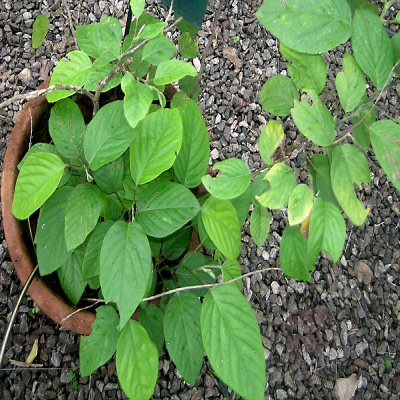Pleurolobus gangeticus J.St. Hil.
Synonyms : Hedysarum gangeticum Linn. , Desmodium gangeticum (L.) DC. , Desmodium gangeticum var. maculatum (L.) Baker
Family : Fabaceae
Group : 1. Dasamoolam, Anti-arthritic/anti-rheumatic/anti-inflammatory
Parts Used : Root
Vernacular Names :-
| English | : | Desmodium |
| Malayalam | : | Orila |
| Hindi | : | Salparni |
| Sanskrit | : | Salaparni |
| Assamese | : | Darh |
| Bengali | : | Salaparni |
| Gujarathi | : | Salwan |
| Kannada | : | Murelehonne |
| Tamil | : | Pulladi |
| Telungu | : | Gitanaram |
Distribution and Habitat: The plant is widely distributed in the tropics and subtropics. It grows wild in the forests of India up to 1500 m. It is also cultivated in the plains and in the lower Himalayas.
Botany: It is an erect diffusely branched undershrub, 90-120 cm in height with a short woody stem and numerous prostrate branches provided with soft grey hairs.
- Leaves: Unifoliate, ovate-lanceolate, membranceous and mottled with grey patches.
- Flowers: White, purple or lilac in elongate lax, terminal or axillary racemes.
- Fruits: Moniliform, 6-8 jointed, glabrescent pods, joints of pods separately pubescent with hooked hairs, joint separating when ripe into indehiscent one seeded segments. Seeds are compressed and reniform.
Properties: The total alkaloid fraction showed hypotensive activity. The root is bitter, anti-inflammatory, analgesic, aphrodisiac, constipating, diuretic, cardiotonic, expectorant, astringent, antidiarrhoeal, carminative, antiemetic, febrifuge and anti-catarrhal.
Chemical constituents: The root contains gangetin, gangetinin, desmodin, N,N-dimethyl tryptamine, hypaphorine, hordenine, caudicine, N-methyl tyramine and β-phenyl ethyl amine.
Uses: Roots are useful in vitiated conditions of vata, anorexia, dyspepsia, haemorrhoids, dysentery, strangury, fever, gout, inflammations, cough, asthma, bronchitis, cardiopathy and debility. The unani preparation “Arq dashmul” contains these roots. It is considered a curative for leucorrhoea and for pains due to cold.
Formulations: Dasamula kwatha, Arq dashmul
Agrotechnology
Soil and climate: Although it can grow on all types of soils, waterlogged and highly alkaline soils are not suitable. Light sandy loam is preferred for commercial cultivation. Desmodium can grow in a variety of climate and soils. However, it prefers tropical and subtropical climatic conditions.
Propagation: Propagated through seeds. Overnight soaking in hot water (70 °C) gives better germination. Seeds can be planted directly in the field or seedlings raised on the nursery beds and transplanted after 2-3 weeks. Transplanting always gives better results in commercial cultivation, as it gives assured crop stand. Planting is done at a spacing of 40 x 20 cm on flatbeds or ridges.
Fertilizers and manures: Organic manures are applied at the time of land preparation and thoroughly mixed with the soil. Phosphatic and nitrogenous fertilizers each at 10 kg/ha are also applied for better crop growth. The inter-row spaces between plants, both in the field and nursery should be kept free from weeds by frequent weeding and hoeing as the plant suffers from weed competition, especially during early stages of growth. Manual hand weeding is usually done. Irrigation of seedlings just after planting is good for crop establishment. Although it can be cultivated as a rainfed crop under humid tropical conditions, irrigation every month is beneficial during summer.
Harvesting: The root is the economic part and harvesting can be commenced after 8-9 months. About 500- 700 kg roots can be harvested from a hectare of land per year.

